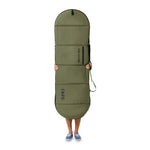There’s nothing quite like packing up your board and heading off on a surf trip. Whether it’s a spontaneous weekend getaway or an overseas surf adventure, exploring new waves is what surfing is all about. But as exciting as travel can be, it comes with one major risk—surfboard damage.
From airport baggage handlers to shifting cargo on a road trip, your board faces plenty of potential hazards. The good news is, with a bit of preparation, you can prevent most of them.
This guide walks you through how to protect your surfboard when travelling—whether you’re flying, driving, or going off the beaten path—with expert tips and recommendations from FARO Surfboard Bags.
Step 1: Choose the Right Surfboard Bag
The most important step in surfboard protection starts before your trip even begins—choosing the right surfboard bag.
A high-quality board bag shields your surfboard from dings, cracks, and UV damage while offering convenient transport features. Here’s what to look for:
-
Durable outer material: Canvas or nylon that resists tearing and abrasion.
-
Ample padding: Especially around the nose and tail.
-
Reinforced zippers and seams: Prevent wear during travel.
If you’re unsure which type suits your trip, FARO’s surfboard bag range covers everything from lightweight canvas covers to full travel-ready coffin bags.
Step 2: Wrap and Pad Your Surfboard Before Packing
Even the best surfboard bag benefits from a little extra protection. Before you slide your board inside, wrap it with foam, bubble wrap, or towels—especially around the nose and tail.
This extra cushioning reduces pressure marks, scratches, and impact damage. You can also:
-
Use pipe insulation around the board’s rails.
-
Place a soft cloth or towel over the fins and wax area.
-
Use your wetsuit or clothes as padding to save luggage space.
Pro Tip: FARO’s padded travel bags already come with high-density foam protection, but adding an extra layer of soft wrap gives you peace of mind during long flights or bumpy drives.
Step 3: Secure and Store Your Fins
Loose or broken fins are one of the most common causes of surfboard travel damage. Always remove your fins before packing and store them in a separate surfboard fin case or pocket.
If your fins can’t be removed, make sure they’re firmly tightened and protected with foam padding. FARO travel bags include internal fin compartments, making this step effortless and organized.
Shop FARO Accessories & Fin Cases
Step 4: Label Your Surfboard Bag
When flying, label your surfboard bag clearly with your name, phone number, and destination address. This ensures that if your bag is misplaced, it can be identified and returned more quickly.
Consider adding a “Fragile” or “Handle with Care” tag for extra visibility. If you’re checking in an 8 ft surfboard bag, labeling it also helps airline staff recognize it as surf equipment, reducing the chances of mishandling.
Bonus Tip: Take a photo of your surfboard bag before check-in—helpful for identifying it later if lost.
Step 5: Handle Your Board with Care
When travelling, treat your surfboard like a travel companion. Avoid dragging or dropping the bag. Always use a luggage cart or trolley at airports and secure your board properly in vehicles.
For road trips:
-
Use high-quality roof rack straps or bungee cords to hold the board in place.
-
Position your board nose forward, fins up, to reduce wind drag.
-
Cover it with a board sock for extra protection from dirt and UV rays.
Step 6: Inspect Your Board Upon Arrival
Once you arrive, inspect your board immediately for damage—look for dings, pressure marks, or cracks.
If you find anything:
-
Take clear photos.
-
Report the damage to the airline before leaving the airport.
-
File a claim and provide the photos as evidence.
It’s much easier to file a claim on-site than once you’ve left.
Step 7: Store Your Board Properly
Once you’ve reached your surf destination, proper storage keeps your board in top condition between sessions.
-
Store it in a cool, dry place, away from direct sunlight.
-
Keep it off the ground using a rack or stand.
-
Always loosen the leash and dry the board completely before packing it back up.
If you’ll be travelling for a long period, FARO canvas bags are ideal—they allow for ventilation while offering durable sun and scratch protection.
Discover FARO Canvas Surfboard Bags
Additional Tips for Surfboard Travel
1. Pack Your Board Correctly
When placing your board inside the bag, center it and fill all gaps with soft items like towels or clothes. This prevents it from shifting during transit. Avoid stacking other luggage on top of the board.
If possible, choose a bag with internal pockets to keep small items (like fins or wax) from sliding around.
2. Choose Direct Flights Whenever Possible
Booking a direct or non-stop flight can significantly reduce the risk of board damage. Fewer layovers mean fewer baggage transfers—and less chance of mishandling.
Also, always check airline surfboard baggage policies before booking. Some airlines are more surf-friendly than others. You can compare surfboard baggage fees on Surfline before you travel.
3. General Travel Tips for Surfers
-
Take photos of your surfboard before travelling for insurance purposes.
-
Research airline surfboard size and weight restrictions in advance.
-
Communicate with staff about your surfboard’s handling requirements.
-
Never store valuables in your surfboard bag.
-
Use eco-friendly surfboard wax to avoid residue buildup during heat exposure.
-
Double-check your board after every major transfer or long drive.

Protecting Your Surfboard on Road Trips
If you’re driving to your next surf destination, you’ll still need to protect your board from heat, movement, and pressure.
Use a Board Sock
A board sock provides lightweight, everyday protection. It’s ideal for short drives or when your surfboard travels inside your car.
Benefits:
-
Prevents wax from transferring to car seats or luggage.
-
Shields your board from scratches and UV rays.
-
Keeps sand and dust off between sessions.
Board socks come in a range of fabrics including cotton, polyester, and stretch-knit materials. FARO’s range of canvas and knit surfboard socks combine stylish design with functional protection—perfect for surfers who love both aesthetics and durability.
Why Choose FARO Surfboard Bags for Travel
FARO isn’t just about functionality—it’s about craftsmanship, sustainability, and reliability.
Here’s why more surfers are switching to FARO for travel protection:
-
Eco-conscious Materials: Made with natural canvas and recycled fabrics.
-
Superior Padding: Designed for impact resistance and long-haul protection.
-
Thoughtful Design: Built-in ventilation, internal pockets, and reinforced stitching.
-
Sizes for Every Surfer: From 6’ to 11’, including custom-fit options.
-
Stylish Look: Clean, modern designs that stand out on the beach or at baggage claim.
Protect Your Quiver Today → Shop FARO Surfboard Travel Bags
Conclusion
Protecting your surfboard when travelling isn’t just about avoiding dents—it’s about preserving your surf experience. By investing in a high-quality board bag, wrapping and labeling your gear properly, and handling it with care, you can travel confidently knowing your board will arrive in perfect condition.
If you’re searching for the ideal surfboard bag, look no further than FARO. From 7’ travel bags to classic canvas covers, FARO’s collection is designed to protect your surfboard and the planet—crafted with durable, sustainable materials that last season after season.
Travel smart. Surf hard. Protect your board with FARO.
FAQs
Q1: What’s the best surfboard bag for air travel?
A padded travel or coffin bag with reinforced seams and extra compartments is best.
Q2: How do I protect my surfboard on a plane?
Wrap it in foam or bubble wrap, remove fins, and pack securely inside a padded surfboard travel bag.
Q3: How should I store my surfboard during long trips?
Keep it in a cool, dry place in a canvas or padded bag, away from direct sunlight.
Q4: Can I take multiple boards on a flight?
Yes, coffin-style bags can hold two or more boards—check your airline’s surfboard baggage policy for extra fees.
Q5: Are FARO surfboard bags eco-friendly?
Yes. FARO bags are crafted from sustainable materials designed to minimize environmental impact.





